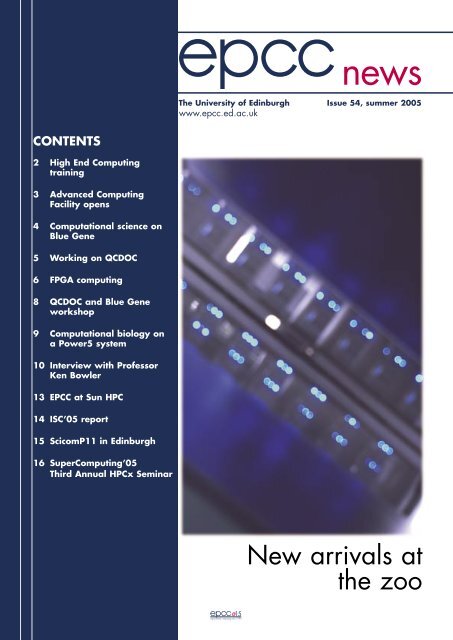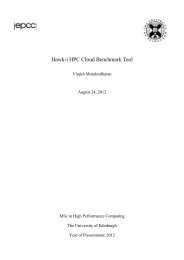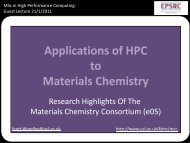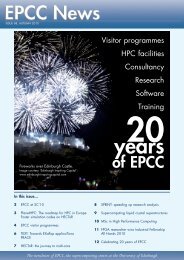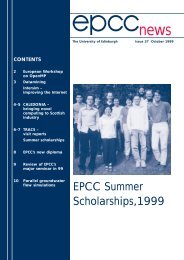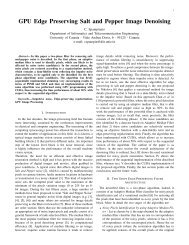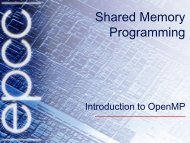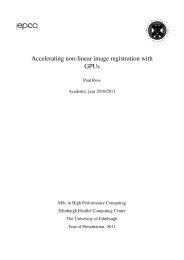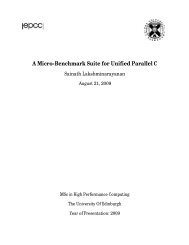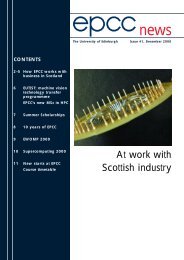Download PDF - EPCC - University of Edinburgh
Download PDF - EPCC - University of Edinburgh
Download PDF - EPCC - University of Edinburgh
You also want an ePaper? Increase the reach of your titles
YUMPU automatically turns print PDFs into web optimized ePapers that Google loves.
newsThe <strong>University</strong> <strong>of</strong> <strong>Edinburgh</strong>www.epcc.ed.ac.ukIssue 54, summer 2005CONTENTS2 High End Computingtraining3 Advanced ComputingFacility opens4 Computational science onBlue Gene5 Working on QCDOC6 FPGA computing8 QCDOC and Blue Geneworkshop9 Computational biology ona Power5 system10 Interview with Pr<strong>of</strong>essorKen Bowler13 <strong>EPCC</strong> at Sun HPC14 ISC’05 report15 ScicomP11 in <strong>Edinburgh</strong>16 SuperComputing’05Third Annual HPCx SeminarNew arrivals atthe zoo
FOCUS: HARDWAREEditorial Gavin J. PringleTo mark our 15th anniversary, this issue focuses on HPCplatforms at <strong>EPCC</strong>. The majority <strong>of</strong> articles are concernedwith the most recent additions to <strong>EPCC</strong>’s ‘zoo’ <strong>of</strong> machines,such as the IBM Blue Gene platform, QCDOC and the newFPGA machine, among others.This zoo has become so large that we have built a new facilityto house it: the Advanced Computing Facility (ACF). The ACFwas formally opened on the 1st <strong>of</strong> July by His Royal Highness,the Duke <strong>of</strong> <strong>Edinburgh</strong>, and this event is covered on theopposite page.The new FPGA machine was also launched recently. We havean article about the machine itself, and another reporting onthe <strong>of</strong>ficial opening.We have reports on the science being produced on our BlueGene system, and Craig Morris talks about the constructionand maintenance <strong>of</strong> QCDOC.Jason Crain reports on the biological simulations runningon the new IBM Power5 system, and I report on <strong>EPCC</strong>’spresence at SunHPC in Heidelberg this year.Just before he took early retirement, Pr<strong>of</strong>. Ken Bowler, one <strong>of</strong><strong>EPCC</strong>’s original founders, talked to me about his involvementwith <strong>EPCC</strong>, supercomputers he has known, and his thoughtson the future. We present a condensed paraphrasing <strong>of</strong> thatconversation.For the second year running, <strong>EPCC</strong> had a booth at theInternational Supercomputing Conference (ISC) inHeidelberg, and we report some <strong>of</strong> the conference highlights.Finally, the beginning <strong>of</strong> June saw <strong>EPCC</strong> host the IBM usersgroup meeting, namely ScicomP11, in conjuncture with SP-XXL. Joachim Hein helped organise this successful event andreports from the front line.<strong>EPCC</strong> becomes a UK High EndComputing Training Centre Adam Carter<strong>EPCC</strong>, and the Centre forScientific Computing at the<strong>University</strong> <strong>of</strong> Warwick, have beenchosen by the UK’s Engineeringand Physical Sciences ResearchCouncil (EPSRC) to be the twoUK High End Computing (HEC) Training Centres.The centre at <strong>EPCC</strong> will provide postgraduate training atMasters level. Students who come to the centre will beundertaking a PhD in their own scientific discipline at theirown UK academic institution but, instead <strong>of</strong> the usual threeyearstudentship, they will be on a longer, four-year HECStudentship programme leading eventually to a PhD. Overthe first three years, they will take a number <strong>of</strong> courses at<strong>EPCC</strong> followed by an HEC research project. This all leadsto an additional qualification: an MSc in High PerformanceComputing from the <strong>University</strong> <strong>of</strong> <strong>Edinburgh</strong>.To combine the PhD and MSc programmes successfully,students are formally enrolled as part-time students at the<strong>University</strong> <strong>of</strong> <strong>Edinburgh</strong>. They will usually visit us for twoblocks <strong>of</strong> seven or eight weeks for the taught part <strong>of</strong> thecourse, spread out over their first three years <strong>of</strong> study. Thiswill allow them to meet and share experiences with theirfellow MSc students without having to spend too much timeaway from their home institution where they are doing thePhD research. Students will spend the first six months at theirPhD institution and then come to <strong>EPCC</strong> for the first set <strong>of</strong>courses after Easter.The training that we provide covers a wide range <strong>of</strong> usefuland exciting areas in HEC. This includes how to writehigh-quality computer programs, how to make programseffectively utilise the world’s largest supercomputers, howto use Grid technologies to harness the Internet effectively,visualisation <strong>of</strong> scientific results and the mathematical toolsand techniques that underpin computational science andengineering. Graduates <strong>of</strong> the MSc in HPC will have acquiredskills that make them employable in a wide range <strong>of</strong> careersranging from post-doctoral academic research beyond theirPhD, to jobs in commercial information technology.The MSc in High Performance Computing is a wellestablishedprogramme providing an excellent grounding inHPC technologies and their practical application.2
FOCUS: HARDWAREOpening <strong>of</strong> the <strong>University</strong> <strong>of</strong> <strong>Edinburgh</strong>’sAdvanced Computing Facility Alison KennedyThe <strong>University</strong> <strong>of</strong> <strong>Edinburgh</strong>’s Advanced Computing Facility(ACF) was formally opened on 1st July 2005 by HisRoyal Highness, the Duke <strong>of</strong> <strong>Edinburgh</strong>, Chancellor <strong>of</strong> the<strong>University</strong> <strong>of</strong> <strong>Edinburgh</strong>. The facility hosts a range <strong>of</strong> highperformance computers with a combined performance <strong>of</strong>20 teraflops and a vast storage area network <strong>of</strong> 155 terabytes,all connected to national and international networks by a10 Gbit/s connection.Around 70 guests attended the opening, including <strong>University</strong>colleagues, senior IBM management (three <strong>of</strong> the computerswere installed in partnership with IBM), representatives <strong>of</strong>the Research Councils and <strong>of</strong> Scottish Enterprise.Dr Arthur Trew, Director <strong>of</strong> <strong>EPCC</strong>, welcomed the guests.He said: ‘Computer simulation has, over the past 25 years,become recognised as the third scientific methodology,complementing theory and experiment. The emergence <strong>of</strong>simulation as this vital scientific tool is due, in no small part,to the pioneering work <strong>of</strong> <strong>Edinburgh</strong> researchers. It has aunique ability to investigate complex scientific phenomenawhich are too fast, too slow, too large, too small, or simplytoo expensive for the traditional approaches.’The Chancellor’s party then went on a short tour <strong>of</strong> thecomputing facilities, while Dr Alan Simpson, <strong>EPCC</strong>’sTechnical Director, gave a talk entitled ‘<strong>EPCC</strong>: A Tradition <strong>of</strong>Excellence’ on the history <strong>of</strong> supercomputing at <strong>Edinburgh</strong>,to the remainder <strong>of</strong> the guests. This was followed by avideo highlighting some <strong>of</strong> the computational scienceprojects making use <strong>of</strong> the facilities at <strong>Edinburgh</strong>. When theChancellor’s party returned from the machine room tour,the Chancellor took the opportunity to speak to some <strong>of</strong> theresearchers and hear more about their work.The formal opening then took place. Firstly, the Principal,Pr<strong>of</strong>essor Tim O’Shea, spoke on the importance <strong>of</strong> the facilityto computational science at the <strong>University</strong>. He also paidtribute to the many colleagues who had played a part in thesetting up <strong>of</strong> the ACF. Next Pr<strong>of</strong>essor Richard Kenway, vice-Principal for HPC and eScience, and Nick Don<strong>of</strong>rio, IBM’sSenior Vice President <strong>of</strong> Technology and Manufacturing, spokeabout the mutually beneficial, close working relationshipbetween the <strong>University</strong> and IBM, which had helped to bringabout the impressive concentration <strong>of</strong> high performancecomputers at the ACF. The Chancellor then unveiled theplaque. This was followed by lunch, a poster session and byfurther machine rooms tours.The opening <strong>of</strong> the ACF underlines the <strong>University</strong> <strong>of</strong><strong>Edinburgh</strong>’s pioneering role in the use <strong>of</strong> computersimulation to tackle some <strong>of</strong> the world’s most complexscientific puzzles. The ACF will enable scientists to makeadvances in such crucial areas <strong>of</strong> research as drug discovery,climate prediction and the design <strong>of</strong> new materials. It willalso help researchers grapple with big scientific questions,such as gaining a better understanding <strong>of</strong> the structure <strong>of</strong>the Universe, or, at the other end <strong>of</strong> the scale, exploring themake-up <strong>of</strong> sub-atomic elementary particles.Since 1980, the <strong>University</strong> <strong>of</strong> <strong>Edinburgh</strong> has been preeminentin exploiting the largest available platforms inHigh Performance Computing (HPC) to push forwardtheir research in a wide range <strong>of</strong> disciplines. <strong>EPCC</strong>, one <strong>of</strong>the leading HPC centres in Europe, acts as the focus for itsinterests in this area. The opening <strong>of</strong> the ACF, supported byan IBM Shared <strong>University</strong> Research award, is the <strong>University</strong>’slatest strategic investment in HPC and its applications.The <strong>University</strong> Principal, Pr<strong>of</strong>essor Timothy O’Shea, said:‘The <strong>University</strong> <strong>of</strong> <strong>Edinburgh</strong> has a world-wide reputation inscience, and also in informatics. These strengths intersect inHigh Performance Computing and we have enjoyed a strongposition in this area through the leadership shown by ourphysicists in particular, by other elements <strong>of</strong> the scientificcommunity, and by <strong>EPCC</strong>. The Advanced Computing Facilityis evidence <strong>of</strong> our very strong and ongoing commitment tomaintain that leadership and to support the most advancedpossible scientific research.’Photos by Douglas Robertson Photography.3
FOCUS: HARDWAREComputationalscience on Blue GeneLorna Smith<strong>EPCC</strong> took delivery <strong>of</strong> the first IBM eServer Blue Genesystem in Europe, in December 2004. This 2048 processorsystem <strong>of</strong>fers 5.7 teraflops performance and providesunprecedented computing performance coupled with verylow power consumption, floor space and cost. Designed tobe highly scalable with low latency communications, thesystem <strong>of</strong>fers a significant advancement in supercomputingtechnology.The system is a key component <strong>of</strong> <strong>Edinburgh</strong>’s computationalscience programme and already a diverse group <strong>of</strong> scientistsare exploiting the system.For example, scientists from the Mathematics Departmenthave investigated the problem <strong>of</strong> modelling financial assetsand liabilities. The application <strong>of</strong> massively parallel computersto financial modelling is novel and has allowed <strong>Edinburgh</strong>scientists access to memory on a scale previously unavailablein this research field. Using our Blue Gene system, they havebeen able to solve a problem over 3 times the size <strong>of</strong> previousstudies.From the School <strong>of</strong> Physics, scientists have been lookingat how proteins assemble from amino acid chains intobiologically-functional structures. This is an important area,as protein mis-folding is attributed to diseases such as cysticfibrosis, CJD and Alzheimer’s. Also from this School, scientistsare focusing on nuclear fusion. With concerns over the longterm strategy for providing energy, this is highly topical. Theyare simulating the behaviour <strong>of</strong> materials to understand theprocesses which govern damage in fission reactors. This workis essential in demonstrating what needs to be done to extendthe lifetime <strong>of</strong> current-day reactors.On the biological side, scientists are attempting to integratebiological data in an attempt to understand how biologicalsystems function. The ultimate goal is to provide a basis forthe true understanding <strong>of</strong> the complex network <strong>of</strong> processesinvolved in life. Hence scientists at the <strong>Edinburgh</strong> Centre forSystems Biology are developing models <strong>of</strong> cellular, organ andorganism level processes using new computational modelsthat integrate gene, protein and metabolite data.More traditional users include scientists from the School <strong>of</strong>Physics, who have been looking at designing new materials,using Lattice-Boltzmann simulations, and scientists fromthe School <strong>of</strong> Chemistry, who have been simulating materialbehaviour.Picture courtesy <strong>of</strong> ITER.<strong>EPCC</strong> continues to work with these, and other researchgroups to ensure they can exploit the system effectively. Thevariety <strong>of</strong> science and the innovative nature <strong>of</strong> the machinemakes this an exciting time indeed!4
FOCUS: TRAINING HARDWAREWorking onQCDOCCraig MorrisCraig with QCDOC.Over the past year, <strong>EPCC</strong> has been involved with theinstallation <strong>of</strong> the first to be commissioned <strong>of</strong> threeQCDOC (QCD-On-Chip) supercomputers in the world.It was installed at the <strong>University</strong> <strong>of</strong> <strong>Edinburgh</strong>’s ACF, inNovember 2004. This purpose-built supercomputer has12,288 processors and a peak speed <strong>of</strong> 10 teraflops. Thereare also a few smaller associated machines, which bring thetotal number <strong>of</strong> processors to 14,464. With an investmentover 5 years <strong>of</strong> £6.6M, this supercomputer will be the mostpowerful computer in the world devoted to lattice QuantumChromodynamics (QCD). QCD describes quarks and gluons,so these computers were designed to simulate particlephysics.I have been working for <strong>EPCC</strong> for three years now, andover the past year I have been heavily involved in the finalconstruction, configuration, debugging and maintenance<strong>of</strong> QCDOC. While working on this project I spent elevenweeks in the US: two weeks at Columbia <strong>University</strong> (CU)and nine weeks at Brookhaven National Laboratory (BNL).At CU I completed my training which involved learningabout the construction, configuration, debugging andtesting <strong>of</strong> the prototype machines. At BNL, where the mainconstruction began, I was involved with the construction <strong>of</strong>putting the production machine (twelve racks) together. Bythe end <strong>of</strong> the sixth week at BNL I was then involved with thedismantling and packaging <strong>of</strong> this machine, which had to beshipped to the UK by a fixed deadline. While the UK machinewas in the process <strong>of</strong> being shipped we began working on thesecond machine which was to stay at BNL. Then, within twovery demanding months back at <strong>EPCC</strong>, reconstructing themachine and with lots <strong>of</strong> hard work and effort, we were ableto get it into production by the end <strong>of</strong> January 2005.amount <strong>of</strong> processors and networking on this machine, ithad 192 motherboards = 12,288 processors, 2304 serialcommunication cables, 1608 ethernet cables and 78 networkswitches. The main advantage <strong>of</strong> the complexity <strong>of</strong> thismachine is its scalability: it can employ between 2 and 12,288processors, if required.While in the US, I had a good time gaining experience andusing some <strong>of</strong> the knowledge and experience that I hadacquired while studying at the <strong>University</strong> <strong>of</strong> <strong>Edinburgh</strong>. Onthe social side I also had a great time travelling round the US.I was able to visit some friends in LA and relatives in Florida,where, to my surprise, I was allowed to drive a ChevroletSuburban 5.8 Litre (you’d be amazed by the amount <strong>of</strong>gallons you get to the mile).I have found it very rewarding indeed to be involved in aproject <strong>of</strong> this size and magnitudeand with the high risk <strong>of</strong> failure andhigh impact <strong>of</strong> success. I feel proudto be part <strong>of</strong> the team that made itwork and turned it into a successfulproduction machine. And now I lookforward to continuing providing ahigh quality service for our users.Right: single rack.Below: Processors running on themotherboard.Most <strong>of</strong> my time was spent running diagnostics and testprograms on motherboards to see if all the processorswere contactable and were communicating correctly andthat the machine’s network infrastructure was functioningcorrectly as well. To give an idea <strong>of</strong> the complexity and the5
FOCUS: HARDWAREFPGA:a new breed <strong>of</strong> supercomputerRob Baxter and Mark Parsons, <strong>EPCC</strong>Graham Fairlie, Scottish Enterprise,Scotland is leading an ambitious project to build an excitingnext-generation supercomputer with spectacular processingcapabilities – and <strong>EPCC</strong> is at the forefront.The FPGA High Performance Computing Alliance (FHPCA)will showcase Scotland’s expertise in the development<strong>of</strong> computers built using ultra high-performance chipscalled Field Programmable Gate Arrays (FPGAs) and couldrevolutionise the way mission-critical applications aredesigned in industries such as defence, life-sciences andenergy.Scottish Enterprise has mobilised £3.6m funding and a worldclasscollaboration <strong>of</strong> industry, academic and governmentexperts to lead the pioneering three-year project.Managed by <strong>EPCC</strong>, Europe’s leading high-performancecomputing centre, the project will draw on effort andtechnology from across the Alliance partners – Xilinx, the$10 billion NASDAQ-listed global supplier <strong>of</strong> programmablelogic devices based in San Jose, California; Nallatech, basedin Glasgow, which has pioneered the development <strong>of</strong> highperformanceFPGA computing solutions for ten years;and Alpha Data, based in <strong>Edinburgh</strong>, which specialises indesigning FPGA systems for customers including Boeing,Lockheed Martin and Motorola.It will also draw upon theexpertise <strong>of</strong> Dr Tom Kean <strong>of</strong>Algotronix who undertookpioneering work in thisfield, and the Institute forSystem Level Integrationwho will contribute to thedissemination <strong>of</strong> skills andknowledge into Scotland’sdesign and applicationcompanies. The firstcommercial computerbased on these devices was designed in Scotland in 1991 byAlgotronix and this new project builds on Scotland’s worldclassreputation in the fields <strong>of</strong> both FPGA technology andhigh performance computing.FPGAs have potentially many times the processing power<strong>of</strong> conventional microprocessors because their hardwareis reconfigurable – algorithms and complex numericalfunctions can be programmed directly onto the silicon,unlike conventional microprocessors which rely on s<strong>of</strong>twareto give them flexibility, s<strong>of</strong>tware which makes themslower. On FPGAs, certain algorithms have been shown torun over 1,000 times faster than the fastest <strong>of</strong>f-the-shelfmicroprocessors.Systems built with FPGAs are also considerably morecompact than conventional systems and a new design can bereconfigured by downloading it and then, by using s<strong>of</strong>twaretools, activate their internal ‘switches’.Until now, FPGAs have been too small in terms <strong>of</strong> capacityand too expensive to make a supercomputer system feasible.But in recent years the chips have got much cheaper whiletheir capacity has massively increased, meaning they arenow becoming widely adopted in mainstream embeddedcomputing.The partners aim to use <strong>of</strong>f-the-shelf components and customs<strong>of</strong>tware to produce a computer with 1 teraflop <strong>of</strong> processingpower, equivalent to 200 times the speed <strong>of</strong> the highestperforming Pentium processor.Rather than targeting one particular application or market,this supercomputer is designed as a general-purpose systemtargeting many potential applications and markets. Thepartners initially aim to develop two or three demonstrationapplications to illustrate the scope and scale <strong>of</strong> thesupercomputer.Continued opposite.6
FOCUS: HARDWARE<strong>EPCC</strong> forges unique alliance to advanceFPGA-based high performance computingMaureen Wilkinson<strong>EPCC</strong> joined its partners in launching the FPGA HighPerformance Computing Alliance (FHPCA) at an industryconference held at Our Dynamic Earth in <strong>Edinburgh</strong> inMay. In excess <strong>of</strong> 100 guests attended the launch, includingFHPCA Alliance partners and representatives from leadingUK and US universities, the Scottish Executive and ScottishEnterprise.The Right Honourable Jim Wallace MSP, Deputy FirstMinister <strong>of</strong> Scotland, Minister for Enterprise and LifelongLearning, welcomed guests, saying: ‘If the Executive isto achieve its key aim <strong>of</strong> continuing to grow Scotland’seconomy we need to encourage effective collaborationbetween industry and academia, to develop new technologicalproducts and to explore new markets.‘The High Performance Computing Alliance is an excellentexample <strong>of</strong> this type <strong>of</strong> successful partnership working– bringing together some <strong>of</strong> the world’s leading computingexperts to develop truly ground-breaking technology whichwill place Scotland at the forefront <strong>of</strong> microelectronicinnovation and design.‘The supercomputer that the Alliance is creating will havefar-reaching benefits in areas such as life sciences, climatechange and games technology and ultimately generate newknowledge and wealth for Scotland.’Next, the Principal <strong>of</strong> the <strong>University</strong> <strong>of</strong> <strong>Edinburgh</strong>, Pr<strong>of</strong>essorTim O’Shea, thanked Jim Wallace and spoke on theimportance <strong>of</strong> the Alliance to the <strong>University</strong> <strong>of</strong> <strong>Edinburgh</strong> andpaid tribute to those who had played a part in establishing theAlliance.Following lunch, during which guests had the opportunity tovisit the stands <strong>of</strong> several Alliance partners, Dr Mark Parsons,<strong>EPCC</strong>’s Commercial Director, gave a talk explaining how theproject would build on Scotland’s reputation in the field <strong>of</strong>FPGA computers.‘This is a fantastic Scottish technology that was developedhere and is being exploited by Scottish companies,’ he said.‘What’s really exciting about this project is that no-one’s evertried to build a big general purpose supercomputer aroundthese chips before. People are always thinking up interestingdesigns, but the supercomputer we’ve come up with is anabsolutely unique system. We’re trying to join a whole lot<strong>of</strong> these high-performance chips together so we can tacklevery large and exciting problems. It’s a real opportunity forScotland to take the lead in a hugely exciting area.’to DNA and the human genome; oil exploration; and largevolume data processing in industries such as financial services.Once complete the supercomputer will be available for thirdpartyaccess, allowing researchers, manufacturers, developersand government organisations worldwide to test and develophigh-performance FPGA applications and devices.If you have any questions about the FHPCA Alliance, please contactm.parsons@epcc.ed.ac.uk.These are likely to target established markets that demandhuge processing power, such as modelling the behaviour <strong>of</strong>complex systems; designers requiring ever-greater processingcapacity; imaging systems in industries including defence andhealth; drug design and bio-analysis, particularly in relationFHPCA Alliance Members:Algotronix – www.algotronix.comAlpha Data – www.alphadata.co.uk<strong>EPCC</strong> – www.epcc.ed.ac.ukThe Institute for System Level Integration – www.sli-institute.ac.ukNallatech – www.nallatech.comXilinx – www.xilinx.com7
FOCUS: HARDWAREBlue Gene (left) and QCDOC.QCDOC and Blue Gene WorkshopNext Generation <strong>of</strong> HPC Architecture National e-Science Centre,<strong>Edinburgh</strong>, 4th–6th October, 2005.Lorna SmithThe Blue Gene and QCDOC architectures <strong>of</strong>fer a significantbreakthrough in supercomputing technology. With thegrowing popularity <strong>of</strong> these systems, a workshop investigatingthe full potential <strong>of</strong> these machines across a wide range <strong>of</strong>applications is highly topical.The first IBM e-Server Blue Gene system in Europewas delivered to <strong>EPCC</strong>, the <strong>University</strong> <strong>of</strong> <strong>Edinburgh</strong>, inDecember 2004. The <strong>University</strong> has also recently installeda QCDOC machine, providing one <strong>of</strong> the world’s mostpowerful systems dedicated to the numerical investigation <strong>of</strong>Quantum Chromodynamics. As the only centre in the worldto host both a Blue Gene and QCDOC system, the <strong>University</strong>is in an unparalleled position to hold such a workshop.The program consists <strong>of</strong> a one-day tutorial giving theattendees the opportunity to gain hands-on experience on theBlue Gene system. This is followed by a two-day workshop,with presentations from users, developers and programmersutilising both systems.We have an excellent range <strong>of</strong> key-note speakers, fromUS organisations such as Lawrence Livermore NationalLaboratory and Argonne National Laboratory, and from thekey Blue Gene sites in Europe such as ASTRON, Jülich and,<strong>of</strong> course, <strong>Edinburgh</strong>.The workshop will be sponsored by IBM, and hosted by<strong>EPCC</strong>, <strong>University</strong> <strong>of</strong> <strong>Edinburgh</strong> at the National e-ScienceCentre, <strong>Edinburgh</strong>, UK.Keynote speakers:Steve Louis, Lawrence Livermore National LabKjeld van der Schaaf, ASTRONHenry Markram, EPFLThomas Lippert, NIC, JülichAndrew Siegel, Argonne National LaboratoryEric Kronstadt, IBMArthur Trew, Director, <strong>EPCC</strong>...Stop Press...Blue Gene System S<strong>of</strong>tware Workshop, <strong>Edinburgh</strong>, UKWe will be holding a System S<strong>of</strong>tware workshop inconjunction with the QCDOC and Blue Gene ApplicationsWorkshop.The workshop will have agendas supporting the systems<strong>of</strong>tware and management aspects <strong>of</strong> Blue Gene.Register now at:www.epcc.ed.ac.uk/BGworkshop8
FOCUS: HARDWARESelf-assembly and hydration inbiological systems:lessons from smallmoleculesJason Crain, School <strong>of</strong> Physics, <strong>University</strong> <strong>of</strong> <strong>Edinburgh</strong>Understanding the principles and processes by which proteinsin aqueous solutions assemble from amino acid chainsinto biologically functional three-dimensional structuresis recognised as one <strong>of</strong> the major challenges spanning thephysical and life sciences. In addition to fundamental interestin the factors surrounding this process, protein mis-foldingevents are also attributed to diseases such as cystic fibrosis,Creutzfeldt-Jakob disorder and Alzheimers. Therefore, thelong-term impact <strong>of</strong> advances in this area also reaches intomedicine and may have future ramifications for protein andpeptide design. The basic molecular-scale issues that underliefolding and other related ‘self-organisation’ phenomena arevery general and concern the following themes:1) Hydration structure: How are the water moleculesorganised around the polar, non-polar and peptide groups <strong>of</strong>complex biomolecules? How is this organization influencedby externally-controllable conditions such as temperature andpressure?2) Molecular flexibility: How flexible are the bonds <strong>of</strong>complex molecules that define overall macromolecular shape?And how is this flexibility affected by hydration structureand other environmental factors such as pressure andtemperature?3) Ionic (H<strong>of</strong>meister) Effects: How does the presence <strong>of</strong>simple inorganic ions influence hydration structure andflexibility?The size, complexity and diversity <strong>of</strong> real proteins andbiomolecules still renders a thorough molecular-levelinvestigation <strong>of</strong> these issues impractical for systems <strong>of</strong> directbiological relevance. A promising emerging strategy in thestudy <strong>of</strong> processes with inherently high levels <strong>of</strong> structuralcomplexity, multiple degrees <strong>of</strong> freedom and competinginteractions makes use <strong>of</strong> so-called model systems whichrepresent extreme approximations <strong>of</strong> ‘real’ macromolecularmaterials. Chosen carefully, and with appropriatecombinations <strong>of</strong> computational and experimental input,co-ordinated investigations on model systems can be veryA simulation <strong>of</strong> complexbiological molecules.powerful, leading to insight into muchmore complex systems. In the specificcase <strong>of</strong> the protein folding problem and self-organisationphenomena in biomolecules, there are potentially many viewsas to what level <strong>of</strong> abstraction relative to a real biomoleculeis ‘useful’ for a particular purpose. Ultimately, there mustbe some compromise found between the degree <strong>of</strong> ‘realism’<strong>of</strong> the system and the level <strong>of</strong> detail at which the system isdescribed. In those cases where the fundamental questionsare general rather than specific to particular biomolecules,extreme simplifications <strong>of</strong> real biological systems may bemade. The benefit <strong>of</strong> this approach is that very sophisticatednew computational (such as polarisable models and pathintegral molecular dynamics) and experimental tools(isotope-labelled neutron diffraction and empirical potentialstructure refinement) can be deployed together for the firsttime to build confidence in new models.With this strategy in mind, a major collaboration betweenthe <strong>University</strong> <strong>of</strong> <strong>Edinburgh</strong> and IBM Research has beenestablished to combine massively parallel supercomputingwith high-resolution neutron diffraction experiments atatomic resolution. To support the project IBM has recentlyannounced a major Shared <strong>University</strong> Research (SUR) awardto <strong>Edinburgh</strong> including leading-edge Power5 microprocessortechnology (16-way SMP, 1.9GHZ p570 processors with128GB RAM) and high performance graphics workstationsenhanced by world-class 9 million pixel LCD monitors forvisualization <strong>of</strong> complex structures. The pSeries system willbe housed at the ACF, where support for the machine will beprovided by <strong>EPCC</strong>. The project also makes extensive use <strong>of</strong>the Blue Gene systems in both the ACF and in the TJ WatsonCenter.9
FOCUS: HARDWAREInterview with Pr<strong>of</strong>essor Ken BowlerPr<strong>of</strong>. Ken Bowler was one <strong>of</strong> <strong>EPCC</strong>’s original founders, the so-called Gang <strong>of</strong> Four, alongwith Richard Kenway, Stuart Pawley and David Wallace. Gavin J. Pringle spoke to Pr<strong>of</strong>.Bowler prior to his retiral this summer. Here is a paraphrased version <strong>of</strong> that meeting.Ken and ChrisBowler.What was the first parallel machine youwere involved with?That was the ICL DAP, in 1980,housed at Queen Mary’s College(QMC) in London. Stuart Pawley was reallythe pioneer, using it for molecular dynamicssimulations.transputers as the processing elements. The original machinewasn’t a serious compute engine for QCD problems, asit didn’t have the computational oomph. But it was aninteresting learning experience for us, dealing with a MIMDarchitecture, compared with the old DAP SIMD. We did lookat a few particle physics calculations, but they were really toycalculations, rather than QCD in anger.It was that time we realised that our problems were suitablefor that kind <strong>of</strong> architecture. We got together with Stuart anddid an initial study with the QMC machine, which was aninteresting exercise in itself, because we had to use an acousticmodem to link up to the machine in QMC, and we got ourresults back through the post!These were interesting results, and we spent some timetalking to Stuart Reddaway, from ICL, who was an architect<strong>of</strong> the DAP. We formed a good relationship with ICL whichresulted in us getting one machine here in ‘82, and a secondDAP in ‘83. The machines were hosted by <strong>Edinburgh</strong><strong>University</strong> Computing Services (EUCS). The then deputydirector <strong>of</strong> the EUCS, Andrew McKendrick, and Mike Brown,the DAP’s system manager, helped us a lot in those early days.The follow up to the Meiko was a big transputer machinecalled the <strong>Edinburgh</strong> Concurrent Supercomputer and it wasaround then that <strong>EPCC</strong> was established. A range <strong>of</strong> differentapplications were ported to that machine.It was a very big transputer-based computing surface, with400 T800 processors; it was certainly a serious machine.That was an interesting exercise because it was essentiallythe start <strong>of</strong> UKQCD collaboration. A groupContinued opposite.So the DAP, for us, was very successful. It enabled us tocompete with people elsewhere who had time on big,expensive vector machines like the Cray and the Cyber 205,whereas the DAP was relatively modest, but, as it was aparallel architecture, we were able to compete effectively.The DAP was an adaptation <strong>of</strong> a memory module <strong>of</strong> the2900 Series ICL mainframe computers, which were greatbig monster machines. It had processing elements wiredinto these memory modules. In a sense, it was a back-endprocessor, where the code ran on the ICL mainframe hostmachine, and the DAP subroutines were executed on thisrather bizarre piece <strong>of</strong> ironmongery.After the ICL DAP, you moved to a Meiko platform.This also predates <strong>EPCC</strong>. It was 1986 when we got ourfirst Meiko machine; it was a very small Meiko, calledthe Computing Surface, and it had the old T414 integerThe Meiko Computing Surface.ICL DAP.10
FOCUS: HARDWARE<strong>of</strong> us from across the UK working in lattice gauge theoryand lattice QCD decided that the only way forward was bycollaboration, and put together a joint proposal for a bigmachine to do lattice QCD.Cray T3E (right)and T3D (below).We were awarded a grant from the Nuclear Physics Board<strong>of</strong> the Science Research Council, which funded the purchase<strong>of</strong> the Meiko i860 box, which, by the standards <strong>of</strong> the time,was quite a powerful machine. It had a peak performance <strong>of</strong>5 gigaflops – a big deal in those days!That was the first instance <strong>of</strong> a UK-wide national service, but it wasonly for one consortium?It was for one consortium, but then it was extended. We gotmore memory and a second smaller machine by collaboratingwith the Car-Parinello Consortium, led by Dominic Tildesleyfrom Southampton. This collaboration really launchedUKQCD on to the world stage and we got a lot <strong>of</strong> goodphysics out <strong>of</strong> that machine from 1990 to 1995, or so. I canstill remember coming in at Christmas and New Year andputting in Exabyte tapes in the Meiko machine to save ourdata. It was very much a string-and-sealing-wax kind <strong>of</strong>operation.So <strong>Edinburgh</strong> Parallel Computing Centre emerged as a support centrefor these consortia. And then we got the Thinking Machines’ CM-200system.Yes, the CM-200 was used by some people in UKQCD forsome <strong>of</strong> our calculations, but we didn’t have exclusive use<strong>of</strong> it, nor exclusive ownership, so it was a relatively smallcontribution to the overall computing needs that we had.They also had this wonderful data store that looked like acocktail bar: the Data Vault!Yes, we had it in the <strong>EPCC</strong> staffroom. It was huge and could hold10 GBytes. We now carry around 60 gigs in an iPod!It is absolutely staggering!Then, after the CM-200, came the Cray T3D.The T3D was funded as a national computing resource andvarious consortia bid for time on that, including UKQCD. Wemade very good use <strong>of</strong> the T3D, as we had a pretty significantallocation <strong>of</strong> time on it; however, it was a change <strong>of</strong> modelfor us. The Meiko had been very much our own baby: an inhousemachine, whilst the T3D was run as a shared resourcewith a pr<strong>of</strong>essional service. But following on from that, weconverted back to the old model, applying to PPARC fora large-scale QCD machine. A procurement exercise wascarried out and the outcome was the Cray T3E.Again, it was a shared facility among three PPARC consortia:Virgo, ourselves and the MHD Consortium. The T3E was ourmainstay for two or three years or so.There was something <strong>of</strong> a hiatus for us after the demise <strong>of</strong> theT3E. The demands on QCD were going up dramatically andwe had to be more ambitious and think on a bigger scale, andthat was the thinking that lead to the QCDOC project.We put together a bid under the JIF heading (JointInfrastructure Fund) without too much hope <strong>of</strong> success, as JIFdidn’t typically fund supercomputers. The bid was originallybased on a machine called QCDSP, designed and built inColumbia <strong>University</strong> (CU), by Norman Christ’s group. Thathad been a successful machine and a big version <strong>of</strong> it hadbeen built and installed in Brookhaven. It was based on TexasInstruments Digital Signal Processing chips with some custominterconnect.But in the meantime, Norman’s ideas became more ambitiousand he started talking with IBM. There was now an upgradedproject based around QCDOC which involved IBM andwe were funded, somewhat to our surprise. After the openThinking Machine’sCM-200 and the DataVault.Continued over.11
FOCUS: HARDWAREPr<strong>of</strong>. Ken Bowler continued.procurement, we went intopartnership with CU and IBM.There’s around 10 teraflopsout at the ACF and there aretwo similar machines out atBrookhaven: one for the RBCA QCDOC chip.collaboration, and one fundedby the US DoE for the US lattice community.This sounds like great news for British QCD!It is, it is. It puts us at the leading edge world-wide. Actually,we’re starting to get results, but most <strong>of</strong> the calculationswe’ve done so far are exploratory. We’re looking in arelatively big parameter space, to find exactly where weshould be running our big simulations. Within the last couple<strong>of</strong> weeks we’ve settled on a parameter set and we’ve juststarted on some large volume simulations.I understand that QCD is only possible thanks to supercomputers?Absolutely, yes. Indeed, it’s fair to say that you always needmore computing resource for lattice QCD, since it’s anopen-ended problem. What we are trying to do is simulatea portion <strong>of</strong> space and time with increasing accuracy, usingMonte-Carlo methods, so the results have a statistical errorassociated with sampling over the ensemble. There’s alsothe systematic errors <strong>of</strong> both simulating a finite volume,rather than the infinite volume <strong>of</strong> space and time, and thediscretisation <strong>of</strong> that space.How long do you expect QCDOC to be switched on for?Tough question. We would hope to have a sensible workinglife in the order <strong>of</strong> five years, and certainly a minimum<strong>of</strong> three, but the technology changes fast. So people havealready begun to think about the next generation. There’salready a competition between custom-built machines, likeQCDOC, and more general purpose clusters. At the moment,it’s probably true that a machine with the architecture likeQCDOC has the edge. I mean, it’s highly optimised for ourproblem, in terms <strong>of</strong> bandwidth to memory in particular,which is the bottleneck in QCD calculations. The QCDOCchip has got a relatively large on-chip memory, and a veryfancy controller for pre-fetching data.There is competition from larger clusters, but QCDOC hasthe edge at the moment in terms <strong>of</strong> price/performance.And certainly, clusters have a problem in terms <strong>of</strong> powerconsumption.Actually, our machine is quite modest in terms <strong>of</strong> clockspeed, as we had to clock down a wee bit to make sure thatthe machine runs reliably and reproducibly. You want to beconfident that the machine will be stable for runs which takearound six months.What is interesting is how much more care we are taking,compared to someone who is using a big commercialmachine: they can just take it for granted that the machineruns correctly.However, the big breakthrough for us is that the newgeneration <strong>of</strong> machines enables us to abandon the so-calledQuenched Approximation, which we had to make just because<strong>of</strong> computational cost. In a quantum field theory, what youcall the vacuum isn’t actually empty. Until very recently,we had to make an approximation where you had to neglectthat effect, but QCDOC gives us now the ability to dowhat’s called a Full QCD Simulation, taking into account thisvacuum polarisation effect. That’s the big difference.The downside is that it costs an enormous amount more todo the computations; it’s a factor <strong>of</strong> 1000 to 10,000 timesmore compute time than before. This is important, however,as our experimental colleagues need results from us to extractfundamental parameters for the Standard Model <strong>of</strong> ParticlePhysics. They can’t get them directly: there’s an intermediatestep that connects the results for decay rates with thosefundamental parameters which requires us to give theexperimentalists what we called QCD matrix elements. Weare under some pressure to really squeeze down our errorsso we can give them computations to an accuracy <strong>of</strong> a fewpercent.12We’ve got various methods <strong>of</strong> checking reproducibility, suchas sophisticated checksum routines built into our codes, whichare monitoring communications between processors. The realwhiz on that is Peter Boyle, who is one <strong>of</strong> the chief architectson QCDOC. He went out there as a UKQCD person tocollaborate with CU and ended up playing a very major rolein the design and running <strong>of</strong> the project.Where does QCDGrid fit into all <strong>of</strong> this?It’s helping us collaborate. QCDGrid is the distributeddata repository for our lattice data. We have a number <strong>of</strong>collaborating sites: several UK groups and a node at CU. AsQCDOC generates these ensembles <strong>of</strong> gauge fields, at leasttwo instances <strong>of</strong> the data are put on QCDGrid and, withincreasingly sophisticated tools and user interfaces, people canlook at the datasets that they want, pull the data down ontotheir machine and process it.Is QCD your only area <strong>of</strong> interaction with <strong>EPCC</strong>?In the early days, we ran training courses in OCCAM, whenthe Meiko machines were here, for anyone to come and learnparallel programming.Continued opposite.
FOCUS: HARDWARE<strong>EPCC</strong> at Sun HPC Gavin J. Pringle<strong>EPCC</strong> attended the Sun HPC meeting in Heidelberg on20-21 June, 2005, where Kevin Stratford presented a talkentitled ‘Cosmology using MPI on the Grid’.This talk described the work that Kevin is carrying out fora joint research activity <strong>of</strong> DEISA, namely CosmologicalApplications. Specifically, Kevin presented results on runninga modified version <strong>of</strong> GADGET2, the famous cosmologicalsimulation from the Virgo Consortium, over two Sun SMPplatforms using PACX-MPI.The practice <strong>of</strong> running a single MPI program, using N sets<strong>of</strong> processors on N separate supercomputers, is known asmeta-computing. It is considered that meta-computing isonly suitable for loosely-coupled applications, where eachsub-computation is relatively independent <strong>of</strong> the other subcomputationsand can be executed within each individualsupercomputer.However, we have found that this cosmological application,which is obviously not loosely-coupled, can be run efficientlyin a meta-computing environment. Indeed, the initial resultsfrom this experiment, as presented at Sun HPC, are bothsurprising and extremely encouraging. Hopefully, this workwill allow Virgo to run far greater simulations <strong>of</strong> the Universethan ever before, employing multiple supercomputers andtheir combined available memory.Image courtesy<strong>of</strong> the VirgoConsortium.For more information on Sun HPC 2005: www.sun.com/productsn-solutions/edu/events/archive/hpc/heidelberg05.htmlDEISA: www.deisa.orgVirgo Consortium: www.virgo.dur.ac.ukGADGET: www.mpa-garching.mpg.de/galform/gadgetPACX-MPI: www.hlrs.de/organization/pds/projects/pacx-mpiI’ve also been involved with the TRACS visitor programme(the forerunner to HPC-Europa). I was involved in both thescientific assessment panel and in hosting visitors. It was goodand I met a lot <strong>of</strong> interesting people. I believe the visitorprogram did <strong>EPCC</strong> a lot <strong>of</strong> good. There was a two-way flow<strong>of</strong> people.My final involvement is through the MSc, where I’ve beenChair <strong>of</strong> the Board <strong>of</strong> Examiners since the start.And what about the future for <strong>EPCC</strong>?I guess collecting machines and hosting them isn’t really<strong>EPCC</strong>’s prime function: that is really technology transfer. Iwould have thought that the demand for that can only grow,so prospects for the future for <strong>EPCC</strong> are still very bright.I think it’s great that they’ve been involved in supportingHPC, and I hope they continue to do so. They’ve got atradition <strong>of</strong> attracting very high-quality young people withHPC experience. I think there’s a very fruitful interplaybetween computational science and the sort <strong>of</strong> thing <strong>EPCC</strong> isinterested in doing, and with any luck that will continue.Then there’s also the big unknown in what direction theGrid will take. How much that will destroy the conventionalmachine with its local group <strong>of</strong> users. Obviously, if the Gridlives up to its promise, that kind <strong>of</strong> model will disappear, aspeople will just tap into the resource they need, although I’llbelieve it when I see it.What plans do you have for your retirement?I used to play the clarinet, so I hope to pick that up again andmaybe learn the keyboard, which is very different. I hope todo a bit more hill-walking, and keep my hand in physics, as faras I’m able.But you won’t be retiring completely, will you?Absolutely, no. What I’m giving up are the admin jobs I hadand the teaching responsibilities, so I hope I’ll still be part <strong>of</strong>the research excitement.13
FOCUS: HARDWAREGlobal cooling in thesupercomputing ecosystem?Kevin Stratford, who was one <strong>of</strong> a number <strong>of</strong> <strong>EPCC</strong> delegates at ISC 2005,reports on the conference.Heat was definitely on the agenda at the 20th anniversarymeeting <strong>of</strong> the International Supercomputer Conferenceheld in Heidelberg in June. As delegates wilted in the bakingmid-summer temperatures, a number <strong>of</strong> speakers alsoturned their attention to a different aspect <strong>of</strong> heat: modernsupercomputers just produce too much <strong>of</strong> the pesky stuff.Large machines are increasingly a strain not only on buildingspace, but also on the electricity supply needed to powerlarge numbers <strong>of</strong> highly clocked chips and the air conditioningrequired to remove the resultant waste heat in order toprevent an expensive meltdown.So it was interesting to note that the leader in the new Top500[1] list <strong>of</strong> supercomputers, presented by Erich Strohmaier<strong>of</strong> the Lawrence Berkeley National Laboratory in California,provided a promise <strong>of</strong> more temperate climes ahead. The65,536 node Blue Gene system at Lawrence LivermoreNational Laboratory (also in California) has clocked 136.8teraflops on LINPACK, the standard benchmark used toproduce the list. The Blue Gene system is interesting becauseits designers have specifically taken pains to address theproblem <strong>of</strong> space and heat efficiency. Each chip, or node, hastwo processors with relatively modest clock rate and hencepower consumption, allowing many <strong>of</strong> them to be packedclosely together. This should allow quite powerful beasts withhundreds <strong>of</strong> thousands <strong>of</strong> processors to be housed in existingmachine rooms.Entertainment at theconference dinner.The concomitant issue <strong>of</strong> scaling real scientific problems tosuch large numbers <strong>of</strong> processors appeared in the followingtalk <strong>of</strong> Horst Simon, again from Lawrence Berkeley NationalLaboratory. To mark the 20th anniversary <strong>of</strong> the conference,Simon gave a fascinating personal overview <strong>of</strong> the topbreakthroughs in supercomputing in the preceding 20 years,and what he considered the most important challenges to befaced in the next 20.As is traditional at such events, these were announced inreverse order. Number three on the list <strong>of</strong> challenges aheadwas exactly the problem <strong>of</strong> huge machines and scaling realproblems to many thousands <strong>of</strong> processors. Simon likenedthis shift in the emphasis <strong>of</strong> supercomputing to a changein an ecosystem, where new dominant species will feed<strong>of</strong>f a changed application landscape. The top <strong>of</strong> the list <strong>of</strong>challenges, which continued the ecological metaphor, heconsidered to be ‘living in a world <strong>of</strong> no growth’, the changethat will inevitably occur when the growth <strong>of</strong> processorpower (famously described by Moore’s law – that processorspeed will double roughly every 18 months) will finallylevel <strong>of</strong>f. Simon also noted the worrying lack <strong>of</strong> currentfundamental research and new thinking to enable such limitsto be circumvented.(For those wondering what Simon rated as the top threebreakthroughs <strong>of</strong> the last 20 years, they were, in reverseorder: 3) the introduction <strong>of</strong> Scientific Visualisation toreally bring home the impact <strong>of</strong> results <strong>of</strong> large numericalsimulations; 2) the availability <strong>of</strong> the Message PassingInterface standard; and 1) John Gustafson’s work [2] on scaledspeed-up. Simon reminded the audience <strong>of</strong> the heated debatethat took place in the early days <strong>of</strong> supercomputing about theultimate limits <strong>of</strong> scalability suggested by Amdahl’s law andthe work Gustafson did in overcoming this ‘mental block’.)So, less power-hungry machines may lead to computerfacilities in future which are able to operate without costly airconditioning. This correspondent, at least, hopes the same isnot true for the Dresden conference centre, where next year’sISC meeting will be held, preferably in cooler conditions.[1] www.top500.org[2] J.L. Gustafson, G.R. Montry, and R.L. Benner, SIAM J. Sci. Stat.Comput., Vol 9, 609 (1988)14
FOCUS: HARDWAREScicomP11 hostedby <strong>EPCC</strong> Joachim HeinAs part <strong>of</strong> the events marking <strong>EPCC</strong>@15,<strong>EPCC</strong> hosted the 11th meeting <strong>of</strong> ScicomPin <strong>Edinburgh</strong> from the 31st <strong>of</strong> May until the 3rd <strong>of</strong> June2005. The meeting was co-hosted with the summer meeting<strong>of</strong> SP-XXL.ScicomP is an international organisation focusing on theperformance and scalability <strong>of</strong> scientific applications on IBMHPC platforms. SP-XXL’s interests are similar to ScicomP;however, their focus is more systems orientated whereasScicomP is more application driven. With <strong>EPCC</strong> being one <strong>of</strong>the key players behind the HPCx system using IBM’s Power4technology and operating the first European IBM eServerBlue Gene, the interests <strong>of</strong> both groups and <strong>EPCC</strong> match verywell. We were able to welcome over a hundred participants in<strong>Edinburgh</strong>.As a member <strong>of</strong> the local organising committee forScicomP11 and having attended the ScicomP sessions, I willreport on the event from a ScicomP perspective. The meetingstarted with the traditional tutorial, focusing on IBM’s Powertechnology. Charles Grassl (IBM) described the features<strong>of</strong> the latest Power5 processor, highlighting differences tothe previous Power4 processor. Roch Archambault (IBMCompiler Development) explained how to use the compilerto make efficient use <strong>of</strong> the processor. With Power5 being anoption for the forthcoming HPCx Phase3, the tutorial provedto be <strong>of</strong> great interest.The second day started with the keynote speeches by RichardKenway (Assistant Principal <strong>of</strong> the <strong>University</strong> <strong>of</strong> <strong>Edinburgh</strong>and Chairman <strong>of</strong> <strong>EPCC</strong>) and Rebecca Austen (Director <strong>of</strong>IBM Deep Computing Marketing). The afternoon saw HPCusers from around the world describe their experiences withIBM systems. Some speakers discussed code improvementswhile others reported on the latest tools to aid performanceanalysis. It was interesting to see how other people solvesimilar problems to the ones I face on a daily basis.Most <strong>of</strong> the third day centred on Blue Gene technology.With a 65536 processor Blue Gene system being the fastestcomputer and an increasing number <strong>of</strong> Blue Gene systemsbeing installed at various computer centres in the world,these presentations were very timely. Manish Gupta andGyan Bhanot (both IBM) reported on the present and futuretechnology, including application performance. Lorna Smith(<strong>EPCC</strong>), Tom Spelce (LLNL) and Richard L<strong>of</strong>t (NCAR)reported on experiences their centres made with their BlueGene systems. On the one hand, the presentations showedthat there are a number <strong>of</strong> teething problems left, while onthe other hand, they showed a number <strong>of</strong> early successes,demonstrating the exciting potential Blue Gene systems haveto <strong>of</strong>fer. In my view, this is a clear case <strong>of</strong> ‘watch this space’.Paul Madden (<strong>University</strong> <strong>of</strong> <strong>Edinburgh</strong>) reported on thescientific s<strong>of</strong>tware development within the UK Car-ParinelloConsortium. The presentation focused on the constraintsimposed by the academic environment and how to ensurequality standards are maintained for the application code.The last day <strong>of</strong> the programme <strong>of</strong>fered a mixture <strong>of</strong> IBMpresentation and talks contributed by our participants. Thesepresentations focused on the technology layers underlyingone’s application. In particular, the presentations on MPI byDick Treumann and the compilers by Roch Archambault (bothIBM) contained many hints on tweaks which might improveapplication performance on our systems.As part <strong>of</strong> the social program IBM invited everyone to theSurgeons’ Hall on Wednesday night. The main social event wason Thursday evening, starting with a walking tour through<strong>Edinburgh</strong>’s Old and New Towns, which was followed bya whisky tasting reception and a dinner in the Georgiansplendour <strong>of</strong> <strong>Edinburgh</strong>’s Assembly Rooms.As is typical for ScicomP meetings, there were manyopportunities to discuss matters with IBM staff membersand experts in the field from other computer centres. To methese exchanges are as valuable as the actual presentations.In summary these were four exciting days. On behalf <strong>of</strong>the organising committee I would like to thank everyonewho participated in the meeting and made it such a success.The next meeting <strong>of</strong> the series will be hosted by NCAR inBoulder, Colorado, starting on the 17th <strong>of</strong> July 2006. Youshould seriously consider going.[1] For further information on ScicomP: www.spscicomp.org[2] For further information on SP-XXL: www.spxxl.org[3] Slides <strong>of</strong> the presentations given at the ScicomP meeting areavailable at www.spscicomp.org/ScicomP1115
FOCUS: HARDWARESuperComputing,2005 Adrian JacksonAs in previous years, <strong>EPCC</strong> will be exhibitingat this year’s conference for High PerformanceComputing, Networking and Storage;SuperComputing 2005. SC|05 is being heldin the Washington State Convention and TradeCenter, in Seattle, from the 12th to the 18th <strong>of</strong> November.Under this year’s theme <strong>of</strong> the ‘Gateway to Discovery’,SC|05 promises to be an exciting mix <strong>of</strong> exhibitions,lectures, tutorials, and technical events from the world <strong>of</strong>High Performance Computing.As well as having a booth in the exhibition space, we will alsobe giving a half-day tutorial on ‘Application Performance onthe Blue Gene Architecture’, presented by Dr Lorna Smith,Dr Mark Bull and Dr Joachim Hein.If you are attending SC|05, you can find us at booth number136. We hope to see you there!Website: sc05.supercomputing.orgImage courtesy <strong>of</strong> Seattle’s Convention & Visitors Bureau.Third HPCx Annual SeminarThe 3rd HPCx Annual Seminar will take placeon Monday 5 December, 2005.It will be held in the Merrison LectureTheatre, in the CCLRC Daresbury Laboratory,Warrington, UK.Further details and registration informationcan be found at:www.hpcx.ac.uk/about/events/annual200516


